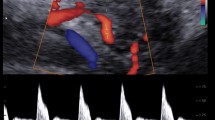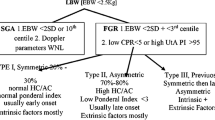Abstract
Fetal growth restriction (FGR) is associated with significantly increased perinatal mortality as well as immediate and long-term morbidity. One of the most challenging aspects of this condition is the ability to accurately define and adequately diagnose it in order to determine appropriate clinical management. Within a common pathogenesis of placental insufficiency, two phenotypes, early and late FGR, have emerged. Early FGR is easier to diagnose, however, as a consequence of extreme prematurity at presentation it can be extremely challenging to manage. Late fetal growth restriction is much more problematic to diagnose but relatively straightforward to manage as delivery is a reasonable option. Areas of research with regards to FGR, which require further evaluation, include the development of more accurate screening tools in order to identify those women at risk and validation of the role of aspirin in the prevention of this condition in a prospective adequately powered trial.

Similar content being viewed by others
References
Mandruzzato G, Antsaklis A, Botet F, et al. Intrauterine growth restriction (IUGR). J Perinat Med. 2008;36(4):277–81.
Kupfermine MJ, Peri H, Zwang E, et al. High prevalence of the prothrombin gene mutation in women with intrauterine growth retardation, abruptio placentae and second trimester loss. Acta Obstet Gynecol Scand. 2000;79(11):963–7.
Figueras F, Gardosi J. Intrauterine growth restriction: new concepts in antenatal surveillance, diagnosis and management. Am J Obstet Gynaecol. 2011;204(4):288–300.
Gordjin SJ, Beune IM, Thilaganathan B, et al. Consensus definition for placental fetal growth restriction: A Delphi procedure. Ultrasound Obstet Gynecol. 2016. doi:10.1002/uog.15884.
Royal College of Obstetricians and Gynaecologists. The investigation and management of the small- for-gestational-age fetus. Clinical guideline number 31, Jan 2014.
American College of Obstetricians and Gynecologists. ACOG Practice bulletin no. 134: fetal growth restriction. Obstet Gynecol. 2013;121(5):1122–33.
Lausman A, Kingdom J. Intrauterine growth restriction: screening, diagnosis and management. J Obstet Gynaecol Can. 2013;35(8):741–8.
Lindqvist PG, Molin J. Does antenatal identification of small-for-gestational age fetuses significantly improve their outcome? Ultrasound Obstet Gynecol. 2005;25(3):258–64.
Gardosi J, Madurasinghe V, Williams M, et al. Maternal and fetal risk factors for stillbirth: population based study. BMJ. 2013;346:f108.
Figueras F, Gratacos E. Update on the diagnosis and classification of fetal growth restriction and proposal of a stage-based management protocol. Fetal Diagn Ther. 2014;36:86–98.
Thompson RS, Trudinger BJ. Doppler waveform pulsatility index and resistance, pressure and flow in the umbilical placental circulation: an investigation using a mathematical model. Ultrasound Med Biol. 1990;16(5):449–58.
Hecher K, Snijders R, Campbell S, et al. Fetal venous, intracardiac and arterial blood flow measurements in intrauterine growth retardation: relationship with fetal blood gases. Am J Obstet Gynecol. 1995;173(1):10–5.
Unterscheider J, Daly S, Geary MP, et al. Optimizing the definition of intrauterine growth restriction: the multicenter prospective PORTO study. Am J Obstet Gynecol. 2013;208(4):290e1-6.
Sinha IP, Smyth RL, Williamson PR. Using the Delphi technique to determine which outcomes to measure in clinical trials: recommendations for the future based on a systematic review of existing studies. PLoS Med. 2011;8(1):e1000393.
Savchev S, Figueras F, Sanz-Cortez M, et al. Evaluation of an optimal gestational age cut-off for the definition of early- and late-onset fetal growth restriction. Fetal Diagn Ther. 2014;36(2):99–105.
Spinillo A, Gardella B, Bariselli S, et al. Placental histopathological correlates of umbilical artery Doppler velocimetry in pregnancies complicated by fetal growth restriction. Prenat Diagn. 2012;32(13):1263–72.
Larroque B, Bertrais S, Czernichow P, et al. School difficulties in 20-year-olds who were born small for gestational age at term in a regional cohort study. Pediatrics. 2001;108(1):111–5.
Crispi F, Biijnens B, Figueras F, et al. Fetal growth restriction results in remodeled and less efficient hearts in children. Circulation. 2011;121(22):2427–36.
Verkauskiene R, Figueras F, Deghmoun S, et al. Birth weight and long-term metabolic outcomes: does the definition of smallness matter? Horm Res. 2008;70(5):309–15.
Ganzevoort W, Alfirevic Z, von Dadelszen P, et al. STRIDER: Sildenafil Therapy in Dismal prognosis Early-onset intrauterine growth Restriction—a protocol for a systematic review with individual participant data and aggregate data meta-analysis and trial sequential analysis. Syst Rev. 2014;3:23. doi:10.1186/2046-4053-3-23.
Hack M, Fanaroff AA. Outcomes of children of extremely low birth weight and gestational age in the 1990s. Semin Neonatol. 2000;5:89–106.
Lee MJ, Conner EL, Charafeddine L, et al. A critical birth weight and other determinants of survival for infants with severe intrauterine growth restriction. Ann N Y Acad Sci. 2001;943:326–39.
Petersen SG, Wong SF, Urs P, et al. Early onset, severe fetal growth restriction with absent or reversed end-diastolic flow velocity waveform in the umbilical artery: perinatal and long term outcomes. Aust N Z J Obstet Gynaecol. 2009;49(1):45–51.
Wood NS, Marlow N, Costeloe K, et al. Neurologic and developmental disability after extremely preterm birth. EPICure Study Group. N Engl J Med. 2000;343(6):378–84.
Ganzevoort W, Rep A, De Vries JI, et al. Prediction of maternal complications and adverse infant outcome at admission for temporizing management of early-onset severe hypertensive disorders of pregnancy. Am J Obstet Gynecol. 2006;195(2):495–503.
Guellec I, Lapillonne A, Renolleau S, et al. EPIPAGE Study Group. Neurologic outcomes at school age in very preterm infants born with severe or mild growth restriction. Pediatrics. 2011;127(4):e883–91.
Lindqvist PG, Molin J. Does antenatal identification of small-for-gestational age fetuses significantly improve their outcome? Ultrasound Obstet Gynecol. 2005;25:258–64.
Gardosi J, Madurasinghe V, Williams M, Malik A, Francis A. Maternal and fetal risk factors for stillbirth: population-based study. BMJ. 2013;346:f108.
Bujold E, Roberge S, Lacasse Y, et al. Prevention of preeclampsia and intra-uterine growth restriction with aspirin started in early pregnancy: a meta-analysis. Obstet Gynecol. 2010;116:402–14.
Crovetto F, Triunfo S, Crispi F, et al. First trimester screening with specific algorithms for early and late onset fetal growth restriction. Ultrasound Obstet Gynecol. 2016. doi:10.1002/uog.15879.
Baschat AA. Doppler application in the delivery timing of the preterm growth-restricted fetus: another step in the right direction. Ultrasound Obstet Gynecol. 2004;23(2):111–8.
Bernstein IM, Horbar JD, Badger GJ, et al. Morbidity and mortality among very-low-birth-weight neonates with intrauterine growth restriction. The Vermont Oxford Network. Am J Obstet Gynecol. 2000;182:198–206.
GRIT study group. A randomised trial of timed delivery for the compromised preterm fetus: short term outcomes and Bayesian interpretation. BJOG. 2003;110(1):27–32.
Thorton JG, Hornbuckle J, Vail A, et al. Infant wellbeing at 2 years of age in the Growth Restriction Intervention Trial (GRIT): multicentred randomised controlled trial. Lancet. 2004;364(9433):513–20.
Lees C, Marlow N, Arabin B, et al. Perinatal morbidity and mortality in early-onset fetal growth restriction: cohort outcomes of the trial of randomized umbilical and fetal flow in Europe (TRUFFLE). Ultrasound Obstet Gynecol. 2013;42:400–8.
Lees C, Marlow N, van Wassenaer-Leemhuis A, et al. 2 year neurodevelopmental and intermediate perinatal outcomes in infants with very preterm fetal growth restriction (TRUFFLE): a randomised trial. Lancet. 2015;385(9983):2162–72.
Stanley JL, Andersson IJ, Poudel R, et al. Sildenafil citrate rescues fetal growth in the catecho-O-methyl transferase knockout mouse model. Hypertension. 2012;59(5):1021–8.
Samangaya RA, Mires G, Shennan A, et al. A randomised, double-blinded, placebo-controlled study of the phosphodiesterase type 5 inhibitor sildenafil for the treatment of preeclampsia. Hypertens Pregnancy. 2009;28(4):369–82.
von Dadelszen P, Dwinnell P, Magee LA, et al. Sildenafil citrate therapy for severe early-onset intrauterine growth restriction. BJOG. 2011;118(5):624–8.
Souka AP, Papastefanou I, Pilalis A, et al. Performance of third-trimester ultrasound for prediction of small-for-gestational-age neonates and evaluation of contingency screening policies. Ultrasound Obstet Gynecol. 2012;39:535–42.
Triunfo S, Crovetto F, Scazzocchio E, et al. Contingent versus routine third-trimester screening for late fetal growth restriction. Ultrasound Obstet Gynecol. 2016;47(1):81–8.
Bricker L, Neilson JP, Dowswell T. Routine ultrasound in late pregnancy (after 24 weeks’ gestation). Cochrane Database Syst Rev. 2008;(4):CD001451.
Oros D, Figueras F, Cruz-Martinez R, et al. Longitudinal changes in uterine, umbilical and fetal cerebral Doppler indices in late-onset small-for-gestational age fetuses. Ultrasound Obstet Gynecol. 2011;37(2):191–5.
Severi FM, Bocchi C, Visentin A, et al. Uterine and fetal cerebral Doppler predict the outcome of third-trimester small-for-gestational age fetuses with normal umbilical artery Doppler. Ultrasound Obstet Gynecol. 2002;19:225–8.
Eixarch E, Meler E, Iraola A, et al. Neurodevelopmental outcome in 2-year-old infants who were small-for-gestational age term fetuses with cerebral blood flow redistribution. Ultrasound Obstet Gynecol. 2008;32:894–9.
Author information
Authors and Affiliations
Corresponding author
Ethics declarations
Conflict of interest
None.
Additional information
Based on the oration given at the Second International Congress of Society of Fetal Medicine held at Hyderabad, 30th August–1st September.
Rights and permissions
About this article
Cite this article
Monaghan, C., Thilaganathan, B. Fetal Growth Restriction (FGR): How the Differences Between Early and Late FGR Impact on Clinical Management?. J. Fetal Med. 3, 101–107 (2016). https://doi.org/10.1007/s40556-016-0098-7
Received:
Accepted:
Published:
Issue Date:
DOI: https://doi.org/10.1007/s40556-016-0098-7




